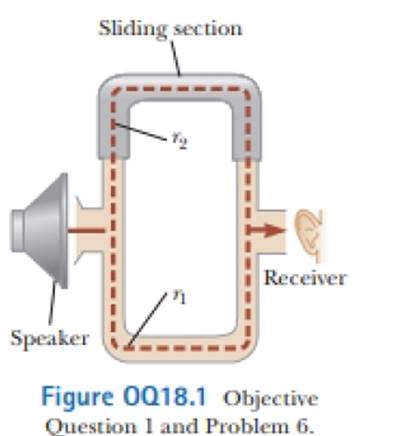
Concept explainers
In figure OQ18.1 (page 566), a sound wave of wave-lenght 0.8 m divides into two equal parts that recombine to interfere constructively, with the original difference between their path lengths being |r2 – r1| = 0.8 m. Rank the following situations according to the intensity of sound at the receiver from the highest to the lowest. Assume the tube walls absorb no sound energy. Give equal ranks to situations in which the intensity is equal.

(a) From its original position, the sliding section is moved out by 0.1 m. (b) Next it slides out an additional 0.1 m. (c) It slides out still another 0.1 m. (d) It slides out 0.1 m more.
The ranking of the situations according to the intensity of sound at the receiver in descending order.
Answer to Problem 18.1OQ
The ranking of the situations according to the intensity of sound at the receiver in descending order is
Explanation of Solution
Given info: The wavelength of the sound wave is
Write the expression for the intensity heard by the receiver.
Here,
For Case (a);
The section is moved out by
The path length
Thus, the value of
Write the expression for phase difference,
Substitute
Thus, the value of
Substitute
Thus the value of
For Case (b);
The section is again moved out by
The path length
Thus, the value of
Write the expression for phase difference,
Substitute
Thus, the value of
Substitute
Thus the value of
For Case (c);
The section is again moved out by
The path length
Thus, the value of
Write the expression for phase difference,
Substitute
Thus, the value of
Substitute
Thus, the value of
For Case (d);
The section is again moved out by
The path length
Thus, the value of
Write the expression for phase difference,
Substitute
Thus, the value of
Substitute
Thus, the value of
The ranking of the intensity of each case is,
Conclusion:
Therefore, the ranking of the situations according to the intensity of sound at the receiver in descending order is
Want to see more full solutions like this?
Chapter 18 Solutions
Physics for Scientists and Engineers (AP Edition)
- Plz solution should be complete No chatgpt pls will upvote .arrow_forwardA box with friction coefficient of 0.2 rests on a 12 foot long plank of wood. How high (in feet) must one side of the plank be lifted in order for the box to begin to slide?arrow_forwardWhat is a good general rule to follow in order to find the best choice of coordinate system to solve a dynamics problem?arrow_forward
- What is the meaning of a first order approximation?arrow_forwardNo chatgpt pls will upvote Already got wrong chatgptarrow_forwardA hydrogen atom has just a single electron orbiting the nucleus, which happens to be a single proton without any neutrons. The proton is positively charged, the electron negatively, but both with the same magnitude of charge given by e=1.602x10-19C. The mass of an electron is 9.11x10-31kg, and the proton is 1.67x10-27kg. Find the ratio of the electrostatic to the gravitational force of attraction between the electron and the proton in hydrogen. \arrow_forward
- What is the third law pair to the normal force as you sit in a chair? What effect does the sun's pull on earth have in terms of third law pairs?arrow_forwardUsing Newton's 2nd law, show that all objects subject to the pull of gravity alone should fall at the same rate. What is that rate?arrow_forwardNo chatgpt pls will upvotearrow_forward
 Principles of Physics: A Calculus-Based TextPhysicsISBN:9781133104261Author:Raymond A. Serway, John W. JewettPublisher:Cengage Learning
Principles of Physics: A Calculus-Based TextPhysicsISBN:9781133104261Author:Raymond A. Serway, John W. JewettPublisher:Cengage Learning Physics for Scientists and Engineers, Technology ...PhysicsISBN:9781305116399Author:Raymond A. Serway, John W. JewettPublisher:Cengage Learning
Physics for Scientists and Engineers, Technology ...PhysicsISBN:9781305116399Author:Raymond A. Serway, John W. JewettPublisher:Cengage Learning Physics for Scientists and Engineers: Foundations...PhysicsISBN:9781133939146Author:Katz, Debora M.Publisher:Cengage Learning
Physics for Scientists and Engineers: Foundations...PhysicsISBN:9781133939146Author:Katz, Debora M.Publisher:Cengage Learning University Physics Volume 1PhysicsISBN:9781938168277Author:William Moebs, Samuel J. Ling, Jeff SannyPublisher:OpenStax - Rice University
University Physics Volume 1PhysicsISBN:9781938168277Author:William Moebs, Samuel J. Ling, Jeff SannyPublisher:OpenStax - Rice University College PhysicsPhysicsISBN:9781938168000Author:Paul Peter Urone, Roger HinrichsPublisher:OpenStax College
College PhysicsPhysicsISBN:9781938168000Author:Paul Peter Urone, Roger HinrichsPublisher:OpenStax College Physics for Scientists and EngineersPhysicsISBN:9781337553278Author:Raymond A. Serway, John W. JewettPublisher:Cengage Learning
Physics for Scientists and EngineersPhysicsISBN:9781337553278Author:Raymond A. Serway, John W. JewettPublisher:Cengage Learning





